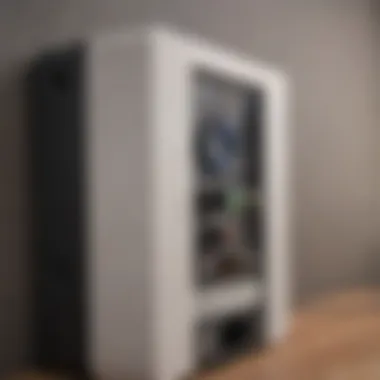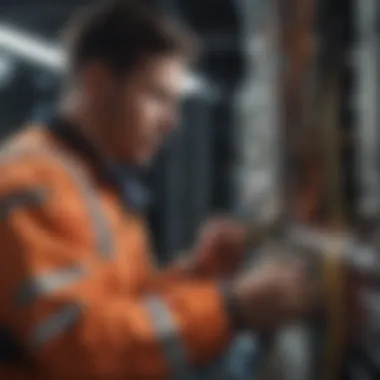Understanding BT FTTP Installation: A Comprehensive Guide


Intro
BT FTTP, or Fiber to the Premises, represents a significant advancement in internet connectivity. This technology delivers high-speed internet directly to homes and businesses using fiber-optic cables. Understanding the installation process is vital for users considering this option.
Users can benefit from faster download and upload speeds, increased reliability, and improved performance during peak usage times. In this guide, we will explore the BT FTTP installation journey, discussing its components, challenges, and benefits. This information aims to empower users to make informed decisions regarding their internet services.
Overview of BT FTTP Installation
Definition
BT FTTP delivers fiber-optic connections directly to individual premises. Unlike traditional copper lines, fiber enables high-speed data transmission, supporting modern digital demands.
Key Features
Some key features of BT FTTP include:
- High-speed internet access with speeds reaching up to 1 Gbps.
- Enhanced reliability with reduced latency.
- Capable of supporting multiple devices simultaneously without degradation in performance.
- Future-proofing as technology evolves.
Purpose and Benefits
The primary purpose of BT FTTP installation is to enhance internet connectivity for residential and commercial users. Some benefits include:
- Improved online experiences for activities like streaming and gaming.
- Enhanced productivity for remote work and education.
- Better support for smart home devices that require constant internet connectivity.
"Fiber to the Premises installation is not just about speed; it’s about laying the foundation for the future of connectivity."
Technical and Equipment Requirements
Equipment Needed
The installation requires several technical components, such as:
- Optical Network Terminals (ONTs) installed inside the premises.
- Outdoor cabinets housing fiber splices and distribution points.
- Fiber-optic cables connecting the outside network to the ONT.
Installation Process
The installation process typically involves several steps:
- Assessment: A technician evaluates the premises and plans the installation.
- Trenching and Ducting: Optical fiber is buried in trenches or within existing conduits.
- Connecting Equipment: ONTs and other devices are installed at designated points.
- Testing and Activation: The connection is tested to confirm operational efficiency before activation.
Challenges of BT FTTP Installation
Users might face challenges during the installation, including:
- Delays caused by bad weather.
- Difficulty accessing certain premises due to geographical constraints.
- Coordination with local authorities for permits.
Benefits of Fiber Technology
Fiber technology offers numerous advantages:
- A more consistent connection with fewer fluctuations.
- Lower latency, enhancing the user experience in time-sensitive applications like video conferencing.
- Greater bandwidth capabilities, allowing for simultaneous multiple user access without loss of quality.
The End
Understanding the intricate details of BT FTTP installation is essential for anyone considering this advancement in internet technology. With insights into the process, equipment, and benefits, users can better navigate their choices and make informed decisions tailored to their connectivity needs.
Foreword to BT FTTP
BT FTTP (Fiber to the Premises) installation marks a critical evolution in broadband technology. Understanding this topic is essential, as it relates directly to the future of internet connectivity for both residential users and businesses. With fiber optic technology, data transmission reaches unprecedented speeds, resulting in a more efficient online experience.
Definition of BT FTTP
BT FTTP refers to a type of broadband service that delivers high-speed internet via fiber optic cables directly to a user's premises. Unlike traditional copper wire systems, which often deteriorate in performance over distance, FTTP utilizes light signals within fiber optic cables. This technology ensures that the broadband connection remains strong and stable regardless of the distance from the network's source.
Importance of Fiber Optic Technology
Fiber optic technology is significant for several reasons:
- High Speed: It supports extremely high data rates, making activities such as streaming and gaming seamless.
- Reliability: Fiber optics are less susceptible to interference, resulting in stable internet performance even during peak usage times.
- Future-Proofing: The capacity of fiber optic networks can be easily expanded, ensuring ongoing compatibility with advancing digital services.
As seen, the relevance of FTTP is vast. Its implementation represents a significant improvement in internet access, which is paramount in today's digital-centric society. This article will delve into the technical aspects, equipment needed, benefits gained, and challenges faced during the installation process.
BT FTTP is vital for advancing internet connectivity and supporting the increasing demands for bandwidth.
Technical Overview of FTTP
The Technical Overview of FTTP is crucial for understanding the infrastructure behind BT FTTP installations. It delves into the workings of modern fiber optic technology and how it compares to traditional broadband systems. By grasping these technical elements, users can appreciate the advantages that come with fiber optic solutions.
Understanding Fiber Optic Cables


Fiber optic cables play a pivotal role in the BT FTTP setup. These cables are made of thin strands of glass or plastic, through which data is transmitted as light signals. The key characteristics of fiber optic cables include:
- High Bandwidth: Fiber optic cables offer superior bandwidth. This means they can carry a larger volume of data compared to copper cables, resulting in faster internet speeds.
- Long Distance Transmission: Unlike traditional cables that experience signal loss over distance, fiber optics can transmit data over much greater lengths without much attenuation. This is essential for connecting distant locations without degrading performance.
- Resistance to Interference: Fiber optic cables are immune to electromagnetic interference, which is a common issue with copper cables. This enhances the reliability of the connection, particularly in urban areas with high levels of electronic noise.
In summary, understanding fiber optic cables is vital to comprehend the efficiency and capability of BT FTTP technology.
Comparison with Other Broadband Technologies
When evaluating BT FTTP, it is beneficial to compare it with other broadband technologies to understand its distinct advantages. Here are the primary technologies:
- ADSL: Asynchronous Digital Subscriber Line uses existing copper telephone lines. While ADSL is widely available, its speed is subject to degradation with distance from the exchange and has limited bandwidth.
- Cable Broadband: Utilizes coaxial cables that also serve television services. While faster than ADSL, it can suffer from network congestion during peak times due to shared bandwidth among users.
- FTTC: Fiber to the Cabinet employs fiber optic cables up to a street cabinet, then uses copper wiring for the final connection to homes. While quicker than ADSL, the copper portion limits its true potential, especially over longer distances.
In contrast, BT FTTP relies solely on fiber optics, offering a more robust, high-performance connection. The advantages include:
- Consistent speeds regardless of distance from the source.
- Excellent performance during peak usage times.
- Greater future scalability options as demand for bandwidth increases.
This comparison highlights the reasons why BT FTTP is a forward-looking choice for internet connectivity, capable of meeting the demands of modern users.
The BT FTTP Installation Process
The process of installing BT FTTP is crucial for users seeking high-speed internet connectivity. Proper installation ensures that users can fully leverage the benefits of fiber optic technology. Effectively following the installation process can mitigate potential issues and enhance overall satisfaction with the service. In this section, we will outline the essential phases of the installation, starting with pre-installation considerations and moving through to the final setup stages.
Pre-Installation Considerations
Before the actual installation takes place, several pre-installation factors must be considered. This stage is vital for understanding the requirements needed for a successful installation.
- Eligibility Check: Determine if your property is eligible for BT FTTP service. This information can be gathered from BT’s official site or customer services.
- Installation Survey: Conducting an installation survey helps to identify potential obstacles. This survey involves assessing the premises and its layout to implement an effective plan.
- Choosing Your Package: Selecting the right package that fits your internet needs is essential. Various packages may offer different speeds and functionalities.
By taking these considerations into account beforehand, users can ensure a smoother installation experience, which can ultimately save time and reduce complications.
Step-by-Step Installation Procedure
The step-by-step installation process can be broken down into several key components, each serving an important role in establishing a functional connection.
Survey and Planning
The survey and planning stage initiates the installation process. It allows technicians to evaluate the site and develop an installation strategy. This step is significant as it helps in anticipatng issues that may arise during installation.
Key characteristics of this phase include:
- Assessment of Infrastructure: Check existing cables and utility lines to avoid interference.
- Planning the Cable Route: Identify where the fiber cables will be routed within the property.
This stage is beneficial as it lays a solid groundwork for the installation. However, if overlooked, it can lead to many complications during the actual setup.
Site Preparation
Once the planning phase is complete, the next step is site preparation. This involves getting the installation area ready for work. A well-prepared site can significantly facilitate the installation procedure.
Key aspects include:
- Clearing the Path: Ensure that the area where cables will be laid is free from obstructions.
- Safety Measures: Adopting necessary safety protocols to protect both workers and property.
The unique feature of this phase ensures that the work can proceed without unnecessary delays. Neglecting site preparation often leads to slowdown in the installation process.
Blowing Fiber Cables
Blowing fiber cables is a critical step in the installation procedure. This technique involves pushing the fiber optic cables through ducts using air, which is an efficient method of installation.
Key attributes include:
- Efficiency: Allows for faster installation compared to traditional methods.
- Reduced Damage: Minimizes physical wear and tear on the cables.
The distinct advantage of this method is its effectiveness in shortening the installation time. However, proper training is necessary to execute this technique successfully.
Connection to the Network
The final step in the installation procedure is connecting the fiber cables to the wider BT network. This step is essential for ensuring that your connection is established correctly.
Important points to consider:
- Activation of Service: After physical connection, activating the service is necessary.
- Testing for Quality: Conduct tests to ensure that the installation meets speed and reliability standards.
This connection stage is pivotal in transforming physical installation to a functional internet service. If problems arise here, users may face connectivity issues post-installation.
Post-Installation Setup
After the installation is complete, the next important phase involves post-installation setup. Completing this stage effectively allows customers to start enjoying their new FTTP service without delay.
- Configuring Equipment: Setting up your router and ensuring the ONT is properly connected is vital.
- Running Speed Tests: Test your internet speed to confirm it meets the promised bandwidth.
- User Education: Familiarizing with any included app or interface tools for managing your connection.


A smooth post-installation setup can ensure that users can access their high-speed internet without issues. Failure to effectively handle this phase can lead to dissatisfaction and potentially limit usage.
Equipment Required for BT FTTP Installation
Understanding the equipment required for BT FTTP installation is vital for achieving optimal results. Proper selection of tools and devices ensures a smooth installation process, minimizing potential issues. This section discusses essential tools, devices, and the specifications needed for routers and ONTs, which are necessary for setting up a reliable internet connection.
Essential Tools and Devices
The installation of BT FTTP requires a set of essential tools and devices to ensure the process is efficient and effective. The primary tools include:
- Splicing Equipment: This is essential for connecting fiber optic cables together. Splicing minimizes signal loss, which is crucial for maintaining internet speeds.
- Cable Blowing Equipment: For the installation of fiber optic cable through ducts, blowing equipment is used. It allows the cable to be pushed through the ducts quickly and smoothly.
- Optical Power Meter: This tool measures the light power of fiber cables. It helps to verify that the signal strength is within acceptable limits after installation.
- Fusion Splicer: This device allows for precise joining of fiber optic cables. A quality splicer can significantly reduce the risk of signal loss during transmission.
- Digital Multimeter: Helpful in checking the electrical properties of the installation, ensuring that all connections are secure and functional.
These tools not only facilitate the installation procedure but also enhance the overall quality of the network service.
Router and ONT Specifications
The router and ONT (Optical Network Terminal) play crucial roles in the BT FTTP installation. They are responsible for converting the fiber signal into an internet connection suitable for your devices.
Router Specifications
- Speed Capability: Choose routers with high bandwidth capabilities to support multiple devices and high-speed streaming. Look for routers that offer speeds of at least 1 Gbps.
- Dual-Band Frequency: A dual-band router can operate on both 2.4 GHz and 5 GHz frequencies, providing greater network flexibility and reducing interference.
- Quality of Service (QoS): Routers with QoS features allow prioritization of bandwidth for critical applications, optimizing performance for activities like video conferencing and gaming.
ONT Specifications
- Ports: The ONT should have multiple ethernet ports to connect various devices directly, allowing you to optimize your home or business network.
- Compatibility: Ensure the ONT is compatible with the service provider's network standards. An incompatible ONT can lead to significant connectivity issues.
- Support for VoIP Services: If you intend to use voice over IP services, choose an ONT that supports it.
Selecting the right router and ONT is essential for ensuring that you maximize the benefits of BT FTTP technology. Proper specifications can lead to better performance and reliability.
Choosing the right equipment for BT FTTP installation not only streamlines the setup process but also lays a strong foundation for years of high-speed internet usage. It is important to consider both the tools needed for installation as well as the specifications of devices that facilitate connectivity.
Challenges in BT FTTP Installation
BT FTTP installation is essential for delivering high-speed internet, but it is not without its challenges. Understanding these challenges can help users and providers navigate the complexities of this technology. There are three major categories of difficulties: technical challenges, physical obstacles, and regulatory hurdles. Each of these elements can affect installation timelines, costs, and the overall success of bringing fiber technology to the end user.
Technical Challenges
Technical difficulties are common during BT FTTP installation. The first aspect is ensuring compatibility between various systems. Different equipment models and software may not integrate seamlessly, causing delays. Network failures can also arise if the installation does not follow protocols.
Moreover, adequately testing the fiber optics for signal strength and quality is crucial. Poor testing can result in insufficient performance, which is detrimental for users relying on a strong internet connection. Improper installation can lead to increased signal loss, necessitating rework. The technological landscape is constantly evolving, requiring technicians to stay updated with the latest standards and practices. Thus, the complexity of technology can introduce unexpected challenges.
Physical Obstacles
Physical challenges pose another set of issues for BT FTTP installation. One major aspect is the existing infrastructure. Older buildings may have limited access points, making it difficult to install fiber lines. This can prolong the installation process and push costs higher. In urban areas, underground cabling may encounter already existing utilities, which complicates installation.
Environmental factors can also play a significant role. Adverse weather conditions such as rain or snow may hinder work flow. Additionally, construction or digging in areas with sensitive ecosystems can raise ethical concerns and complicate logistics. Therefore, addressing these physical barriers is necessary for successful installations.
Regulatory Hurdles
Regulatory challenges can significantly affect BT FTTP installation. Permitting processes may be slow and burdensome, requiring extensive documentation and approvals from local authorities. Delays in obtaining these permits can stall installation projects for weeks or even months.
Furthermore, compliance with local laws and regulations is essential. In some regions, there may be specific requirements concerning fiber optics installation that must be addressed. Failure to comply can render installations illegal and result in penalties. Wireless and telecommunications regulations also add complexity. Providers must ensure that their installations conform to national regulations while still meeting market demand.
With a thorough understanding of these challenges, stakeholders can better plan their BT FTTP installation strategies.
In summary, BT FTTP installation faces numerous challenges that range from technical and physical to regulatory. Recognizing these obstacles allows both users and service providers to mitigate risks and streamline the installation process for effective outcomes.
Benefits of BT FTTP
The adoption of BT FTTP (Fiber to the Premises) technology is growing rapidly. The benefits are substantial, making it vital for households and businesses alike. This section details these advantages, which ultimately enhance overall internet experience for users.
Increased Internet Speeds
One of the most prominent benefits of BT FTTP is the increased internet speeds it offers. Unlike traditional copper connections, fiber optic technology transmits data using light signals. This results in much higher bandwidth capabilities, supporting faster download and upload speeds. Users can experience gigabit speeds, which are far superior to those provided by ADSL broadband.
- Downloading Large Files: The speed enhances efficiency when downloading large files, such as videos or software. Users can complete tasks in a fraction of the time.
- Streaming Services: Services such as Netflix or Hulu benefit from faster streaming. With lower buffering times, users enjoy seamless viewing experiences.
- Online Gaming: Gamers will experience reduced lag and a smoother connection, crucial for competitive gaming.
In summary, increased internet speeds directly contribute to a more productive and enjoyable online experience.
Enhanced Reliability
Reliability is another key advantage associated with BT FTTP installations. Fiber optic cables are less susceptible to interference compared to copper lines. As a result, users experience fewer outages and a more stable connection.
- Environmental Resistance: Fiber is more resistant to extreme weather conditions. Heavy rains or high winds are less likely to affect the service.
- Consistent Performance: High usage times do not typically impact fiber connections as significantly as other types might. This means that during peak hours, reliability remains intact.
- Reduced Maintenance Issues: Fiber optics require less maintenance than traditional infrastructure, translating to fewer disruptions in service.
Enhanced reliability ensures that users can rely on their internet connection for work, study, or leisure activities with confidence.
Future-Proof Technology
Investing in BT FTTP is also about future-proofing internet capabilities. The technology not only meets current demands but is designed to accommodate future advancements.


- Scalability: Fiber optic networks are highly scalable. As user demands increase and technology evolves, upgrades can often be made without major overhauls.
- High Demand in Future: With the rise of smart homes and connected devices, the need for robust internet will undoubtedly grow. BT FTTP positions users to easily adapt to these changes.
- Long Lifespan: Fiber optic cables have a longer lifespan compared to copper alternatives. This durability means users will benefit from reliable service over many years.
Investing in BT FTTP provides assurance that the infrastructure will not become obsolete, safeguarding your internet needs for years to come.
User Experience with BT FTTP
User experience is central to understanding how BT FTTP can transform internet connectivity for various users. This section will evaluate both residential and business experiences with BT FTTP, providing insight into its usability, performance, and overall effectiveness.
Impact on Residential Users
The implementation of BT FTTP has significantly enhanced the internet experience for residential users. With BT FTTP, homes are connected directly to the fiber optic network, enabling high-speed internet access. This results in various advantages:
- Faster Speeds: Users can enjoy upload and download speeds that often exceed 100 Mbps, allowing for smooth streaming, gaming, and video conferencing.
- Reduced Latency: BT FTTP minimizes latency, ensuring that users experience less lag during online activities, which is critical for gamers and remote workers.
- Multiple Devices: Households with multiple users and devices can benefit from consistent performance, eliminating slowdowns that can occur with traditional broadband.
Furthermore, many families appreciate a more reliable connection, especially in areas where service interruptions are common.
As a residential user, installation processes are somewhat seamless but still require some consideration. Responsiveness of service providers and the ability to set up parental controls or security features can greatly influence overall satisfaction.
Benefits for Businesses
For businesses, BT FTTP presents an array of advantages that go beyond just fast internet.
- Enhanced Productivity: Employees can work more efficiently, as high-speed internet supports seamless videoconferencing and quick file transfers.
- Improved Customer Interactions: Businesses rely heavily on stable and fast connections to manage online operations, from e-commerce platforms to customer service chatbots.
- Scalability: With fiber optic technology, businesses can easily scale their internet needs as they grow without requiring significant infrastructure changes.
- Technological Advancements: BT FTTP users often report being better positioned to adopt new technologies, such as cloud computing or Internet of Things devices, fostering innovation.
Overall, BT FTTP's impact on both residential and business users is substantial. Its design facilitates an enhanced user experience, paving the way for smoother, more effective online interactions.
"The access to reliable and fast internet through BT FTTP has fundamentally changed how we work and connect with others, allowing for a virtually seamless digital experience."
Installation Timeline and Planning
Installing BT FTTP requires careful consideration of the timeline and planning involved. Proper planning can reduce downtime and ensure a smoother installation experience. Understanding this aspect leads to better expectations and the capacity to manage potential inconveniences, contributing to overall satisfaction with the service.
Average Installation Timeframe
The average timeframe for BT FTTP installation varies depending on several factors but typically ranges from a few days to a few weeks. This duration is influenced by aspects such as location, the complexity of the installation site, and the availability of resources.
For many residential users, a standard installation might be completed within one to three days. This includes the necessary preparation work, fiber cable installation, and connection to the network. For businesses, the installation might take longer due to larger premises and more extensive networking requirements.
Factors Affecting Duration
Several key factors can affect the duration of a BT FTTP installation. Understanding these can help set realistic expectations and aid in planning:
- Location: Urban areas may experience quicker installation times compared to rural locations where access to infrastructure can be limited.
- Site Preparation: The condition of the installation site is crucial. If significant groundwork is needed, this can delay the process.
- Permitting: Local regulations can necessitate permits, which may add time to the timeline if not managed efficiently.
- Access to Existing Infrastructure: If existing cables and network points are already in place, the installation may be quicker. However, digging new trenches or making alterations can extend the timeframe.
- Workforce Availability: The availability of trained personnel can also impact how quickly the installation is completed. More workers can lead to faster installation, while workforce shortages can cause delays.
Effective planning involves communicating with the service provider to understand these timelines and all necessary preparations.
Selecting a BT FTTP Service Provider
Choosing the right service provider for BT FTTP is crucial for ensuring a smooth installation and optimal internet experience. With various companies offering different services and packages, the selection process requires careful consideration of several factors.
Criteria for Choosing a Provider
When selecting a BT FTTP service provider, it is important to evaluate a few key criteria:
- Service Availability: Not all providers offer BT FTTP in every area. Check if the service is available in your location before proceeding.
- Customer Reviews: Research customer experiences. Online reviews can provide insights into service reliability and customer support. Look for both positive and negative feedback to form a balanced view.
- Technical Support: Good technical support is essential. Ensure that the provider offers accessible customer service for troubleshooting and assistance, especially during installation.
- Performance Consistency: Providers should offer transparent information about connection speeds and reliability. Look for average speeds and any reported outages.
- Pricing Structure: Analyze the pricing options, including contract terms, set-up fees, and hidden charges. Compare what each provider includes in their basic package.
These criteria can help you narrow down your options and find a provider that meets your needs.
Comparing Packages and Offers
Once you have identified potential providers, the next step is to compare their packages and offers. Here are some aspects to consider:
- Internet Speeds: Different providers offer varying speeds. Decide on the speed that fits your use case, whether you are streaming, gaming, or working from home.
- Data Limits: Review if there are any data caps. Some providers might limit your internet use, which can impact your experience.
- Bundled Services: Many providers offer bundles that may include TV, phone, or mobile services. Consider if a bundle provides value for you.
- Promotional Offers: Pay attention to introductory prices. Some providers offer lower prices for the first few months before reverting to the standard rate.
- Contract Length: Evaluate the commitment required. Shorter contract terms may offer flexibility but might come at a higher monthly cost.
Carefully comparing these elements will lead you to an informed choice that aligns with your specific internet needs.
Finale
The conclusion serves as a pivotal segment in understanding BT FTTP installation. It encapsulates the core aspects discussed in the article, reaffirming the significance of fiber technology in today’s internet landscape. As bandwidth demand grows, understanding BT FTTP’s framework becomes not just relevant but a necessity.
Summary of Key Points
In summary, BT FTTP offers several key advantages:
- Increased Internet Speeds: By delivering high-speed internet directly to premises, BT FTTP provides unparalleled speeds compared to traditional copper lines.
- Enhanced Reliability: Fiber-optic technology is more resistant to interferences, ensuring a stable connection.
- Future-Proof Technology: This system is designed to accommodate future demands for higher bandwidth, making it a smart long-term investment.
These points highlight the technology's ability to meet modern connectivity needs effectively.
Future Outlook for BT FTTP
The future outlook for BT FTTP installation is optimistic. With more households and businesses recognizing the value of high-speed internet, the demand for FTTP will likely increase.
Several factors will influence this trajectory:
- Infrastructure Expansion: Ongoing investments in fiber networks will improve accessibility across rural and urban areas.
- Technological Advancements: As fiber technology evolves, new solutions may emerge, offering even greater efficiency and performance.
- Regulatory Support: Government initiatives may promote fiber expansions, making installation easier and more widespread.
As we move forward, the integration of BT FTTP into everyday life will reshape not only internet usage but also impact various sectors including education, remote working, and digital businesses.



